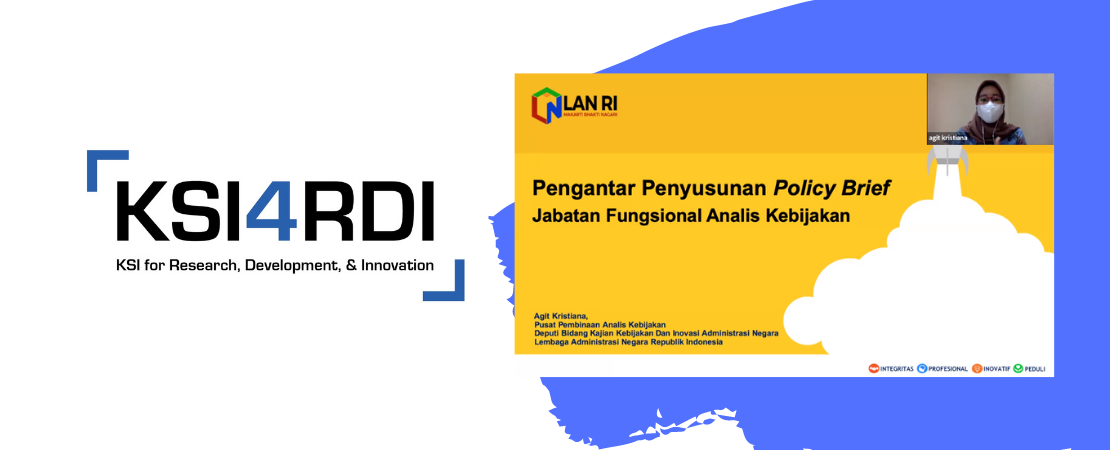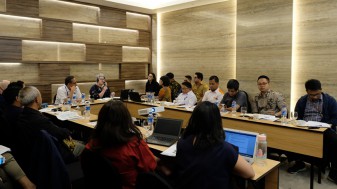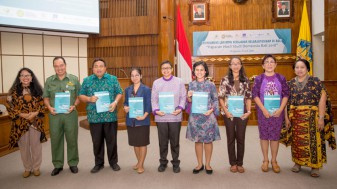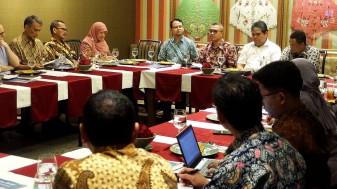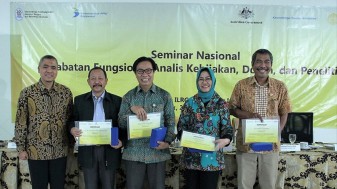In addition to being user-oriented, policy briefs must be concise, easy to understand, and supported by strong evidence. This was stated to mark the opening of the discussion of the 17th Knowledge Sector Initiative for Research, Development, and Innovation or KSI4RDI held online, Thursday (16/9) to support the preparation of development pollicy briefs. With the theme “Preparing Policy Briefs as an Effort to Optimize the Role Policy Analysts Functional Position (JFAK) in the Formulation of Policy Recommendation for the Development of RPJMN and RPJPN” the discussion was held by KSI in collaboration with the Center for Policy and Performance Analysis (PAKK) of the Ministry of National Development Planning (PPN)/Development Planning Agency National (Bappenas). The objective was to optimize JFAK's role in the policy making cycle within the Ministry of National Development Planning/Bappenas.
In this discussion, an explanation regarding the preparation of a policy brief was delivered by a Policy Analyst at the Center for Policy Analysis Development of the State Administration Agency (Pusaka LAN) Agit Kristina. Other panelists in this discussion were a Policy Analyst from the Secretariat General of the DPR RI who was also the 2016-2019 Chair of the Indonesian Policy Analyst Association (AAKI) Riyadi Santoso and a Policy Analyst from the National Research and Innovation Agency (BRIN), who was also the Secretary General of AAKI. 2016-2019, Aflahur Ridho. The Head of the Human Resources Bureau (HR) Emmy Suparmiatun also gave directions and closing remarks at the end of the discussion.
In her presentation, Agit explained that a policy brief was a concise, impartial document that focused on certain issues that needed to be addressed by policy makers. This document also presented the rationale behind the alternative policies which were selected to be discussed and argued in the study. According to her, policy briefs must be user-oriented (i.e. the policy makers). "Generally, they (the policy makers) need it (the policy brief) to learn about complex issues in a short time, or make decisions but they only have incomplete or one side of information, or when they are motivated to make their superiors or constituents happy," said Agit.
Agit added, there were several important characteristics, prerequisite to policy briefs/policy analyst products. Among others, they need to focus on achieving goals to satisfy the target audience. Second, they must be based on strong evidence to support the analysis of issues. “In addition, policy analyst products must be concise, easy to understand, clear, and simple. The display of policy analyst documents must also be attractive or pleasing to the eye so that it can impress the audience,” she said.
Agit added, the basic thing that a policy analyst must have is the ability to do self- as well as team- management. A policy analyst is also required to have knowledge of public policy content, research methods, policy analysis techniques, writing and publication skills, as well as knowledge of the thematic area and the process of preparing policy recommendations.
Compared to other policy texts, continued Agit, policy briefs are more concise, simple, attractive in terms of their layout and display, and they can be produced without having to wait for research to be completed, and their design can be customized for their target audience (user oriented). “In terms of structure, policy briefs consists of the title, executive summary, introduction, problem description, policy recommendations, attachments, and bibliography," she said.
Riyadi also added, it was very important to be clear about the scope of policy recommendations before deciding on the hot current issues or problems to discuss in the document. He gave an example, when the issue of crude palm oil (CPO) from Indonesia, in particular pertaining to forest conversion and human rights issues, was questioned by the European Union, AAKI then developed six policy briefs. "At that time, AAKI managed to prepare policy recommendations to support Indonesian diplomacy on the issue of oil palm in Europe," he said.
Also, according to Aflahur, the author's standpoint will be crucial in determining the perspective of the brief. As an example, he mentioned that a policy brief prepared by a person with a functional position as a writer (JFP) will offer a different perspective compared to that written by a functional policy analyst (JFAK), as both will present different contexts and views in line with the scope of work of the writers. The policy briefs also need to include credible evidence or data to support the recommendations. Also regarding to the credit scores, policy analysts do not have to limit themselves to only write briefs for their own agency. They can work with a think tank, for example, and then submit it as a credit score.
“On the other hand, policy briefs are not only always submitted exclusively to clients or superiors. Policy briefs with an educational themes can also be published the agency’s website to provide information and education for the public," said Aflahur.
To conclude the discussion, it was mentioned that JFAKs in Bappenas would apply proactive approach in preparing policy briefs. This meant that JFAK would begin with their own initiative to produce policy recommendations in relation to RPJPN or RPJMN issues and submit them to the relevant technical directorates.
In addition, six major themes of policy briefs have been selected to be prepared by JFAKs at Bappenas. The six themes include poverty, environment, education, economic transformation, digital transformation, and Bappenas internal budget. The next meeting was agreed to be held on Friday, November 19, 2021, with the agenda of presenting the preliminary policy briefs of the selected themes to the relevant technical directorate.
Before moving on to the second meeting, several issues must be resolved within the internal JFAK of Bappenas and with the related technical directorates, namely: (a) Agreeing on the author for each selected theme and assigning a lead author for each policy report; (b) Fostering informal relations with the technical directorate related to the above theme to identify the initial problems and adjust the presentation of user-oriented policy briefs; and (c) Writing the initial draft of the policy briefs once the writing structure has been planned and completing the writing within one month effective from the date the first meeting took place.
The series of writing activities that will be carried out until December 2021 is also supported by the Head of HR Bureau, Emmy, to ensure the sustainable policy-making process.
KSI4RDI (KSI for Research, Development and Innovation) is an interactive discussion initiated by KSI, a partnership between the governments of Indonesia and Australia with funding from the Australian Department of Foreign Affairs and Trade (DFAT). KSI4RDI discussion activities are held regularly with the aim of supporting increased use of evidence in the policy-making process which will directly encourage policymakers to produce policies that are more inclusive and well-targeted. (*)

